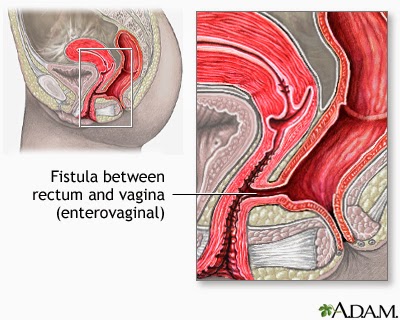HAEMORRHOIDS
Hemorrhoids are swollen, inflamed veins around the anus or lower rectum. They are either inside the anus or under the skin around the anus. They often result from straining to have a bowel movement. Other factors include pregnancy, aging and chronic constipation or diarrhea.
Hemorrhoids are very common in both men and women. About half of all people have hemorrhoids by age 50. The most common symptom of hemorrhoids inside the anus is bright red blood covering the stool, on toilet paper or in the toilet bowl. Symptoms usually go away within a few days.
Treatment may include warm baths and a cream or other medicine. If you have large hemorrhoids, you may need surgery and other treatments.
FISTULAS
A fistula is an abnormal connection between an organ, vessel, or intestine and another structure. Fistulas are usually the result of injury or surgery. It can also result from infection or inflammation.
Inflammatory bowel disease, such as ulcerative colitis or Crohn's disease, is an example of a disease that leads to fistulas between one loop of intestine and another. Injury can lead to fistulas between arteries and veins.
Fistulas may occur in many parts of the body. Some of these are:
-Arteriovenous (between an artery and vein)
-Biliary (created during gallbladder surgery, connecting bile ducts to the surface of the skin)
-Cervical (either an abnormal opening into the cervix or in the neck)
-Craniosinus (between the space inside the skull and a nasal sinus)
-Enterovaginal (between the bowel and vagina)
-Fecal or anal (the feces is discharged through an opening other than the anus)
-Gastric (from the stomach to the surface of the skin)
-Metroperitoneal (between the uterus and peritoneal cavity)
-Pulmonary arteriovenous (in a lung, the pulmonary artery and vein are connected, allowing the blood to bypass the oxygenation process in the lung (pulmonary areriovenous fistula).
-Umbilical (connection between the navel and gut)
Types of fistulas include:
-Blind (open on one end only, but connects to two structures)
-Complete (has both external and internal openings)
-Horseshoe (connecting the anus to the surface of the skin after going around the rectum)
-Incomplete (a tube from the skin that is closed on the inside and does not connect to any internal structure)
PROCTITIS
Proctitis is an inflammation of the rectum. It can cause discomfort, bleeding, and the discharge of mucus or pus. There are many causes of proctitis. They can be grouped as follows:
-Autoimmune disease
-Harmful substances
-Non-sexually transmitted infection
-Sexually transmitted disease (STD)
Proctitis caused by STD is common in people who have anal intercourse. STDs that can cause proctitis include gonorrhea, herpes, chlamydia, and lymphogranuloma venereum.
Infections that are not sexually transmitted are less common than STD proctitis. One type of proctitis not from an STD is an infection in children that is caused by the same bacteria as strep throat.
Autoimmune proctitis is linked to diseases such as ulcerative colitis or Crohn´s disease. If the inflammation is in the rectum only, it may come and go or move upward into the large intestine.
Proctitis may also be caused by some medicines, radiotherapy or inserting harmful substances into the rectum.
Risk factors include:
-Autoinmune disorders
-High-risk sexual practices such as anal sex
-Symptoms
-Bloody stools
-Constipation
-Rectal bleeding
-Rectal discharge, pus
-Rectal pain or discomfort
-Tenesmus (pain with bowel movement)
Most of the time, proctitis will go away when the cause of the problem is treated. Antibiotics are used is an infection is causing the problem.
Corticosteroids or mesalamine suppositories may relieve symptoms for some people. The outcome is good with treatment.
Possible Complications: anal fistula, anemia, recto-vaginal fistula in women and severe bleeding.
LOCAL PREPARATIONS FOR ANAL AND RECTAL DISORDERS
1. Soothing haemorrhoidal preparations containing mild astringents such as bismuth subgallate, zinc oxide and hamamelis may give symptomatic relief. Preparations with local anaesthetics should be used for short periods only since they may cause sensitisation of the anal skin.
2. Compound haemorrhoidal preparations with corticosteroids:
-Anugesic-HC
-Anusol-HC
-Perinal
-Proctofoam HC
-Proctosedyl
-Scheriproct
-Ultraproct
-Uniroid-HC
-Xyloproct
-Anugesic-HC
-Anusol-HC
-Perinal
-Proctofoam HC
-Proctosedyl
-Scheriproct
-Ultraproct
-Uniroid-HC
-Xyloproct
3. Rectal sclerosants:
-Phenol (oily phenol injection is used to inject haemorrhoids particularly when unprolapsed).
-Phenol (oily phenol injection is used to inject haemorrhoids particularly when unprolapsed).
4. Management of anal fissures:
-Glyceril trinitrate (Rectogesic).
-Glyceril trinitrate (Rectogesic).
Source:
-http://www.nlm.nih.gov/medlineplus/
-BNF 57 March 2009



No hay comentarios:
Publicar un comentario